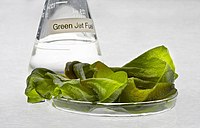
Photo from wikipedia
The biochar BC-450 derived from the extracted marine Chlorella sp. residue (EMCR) had high surface area (266 m2/g) and was rich in ash and O-functional groups. Its characteristics are suitable for… Click to show full abstract
The biochar BC-450 derived from the extracted marine Chlorella sp. residue (EMCR) had high surface area (266 m2/g) and was rich in ash and O-functional groups. Its characteristics are suitable for heavy metal adsorption. The adsorption parameters were investigated to optimize the removal efficiency of Cr(VI), Zn(II) and Ni(II) from aqueous solution by conventional adsorption (CA) and by ultrasonication adsorption (UA). The adsorption was fit by Langmuir isotherm and by pseudo-second-order model. The equilibrium times were 10, 8, 15 min and 40, 60, 80 min for removal of Cr(VI), Zn(II) and Ni(II) with UA and CA, respectively. The maximum adsorption capacities of Cr(VI), Zn(II) and Ni(II) for CA and UA were 15.94, 17.62 and 24.76 mg/g and 18.86, 21.31 and 27.45 mg/g, respectively. UA presented 1.1-1.3 times greater removal efficiencies than CA in much shorter time. The EMCR is a promising feedstock for producing low cost and high efficiency adsorbents.
Journal Title: Bioresource technology
Year Published: 2019
Link to full text (if available)
Share on Social Media: Sign Up to like & get
recommendations!